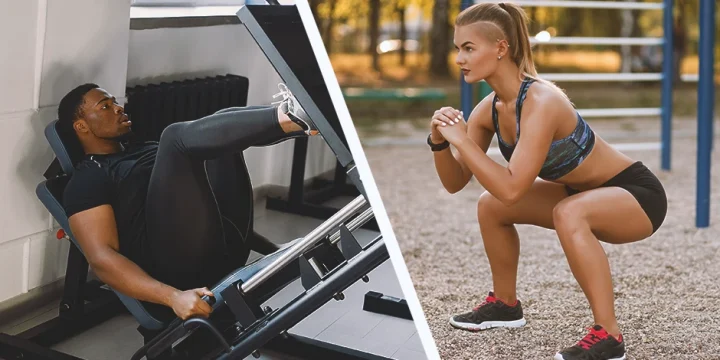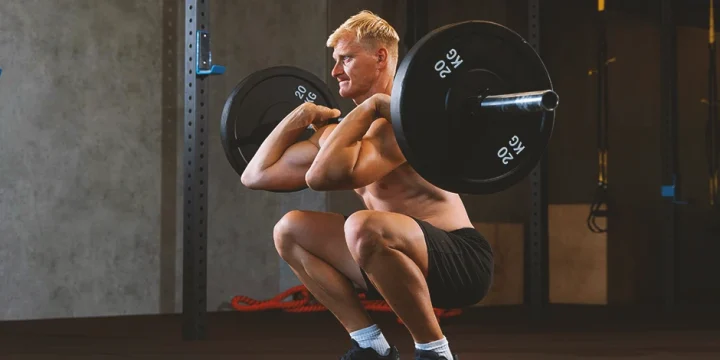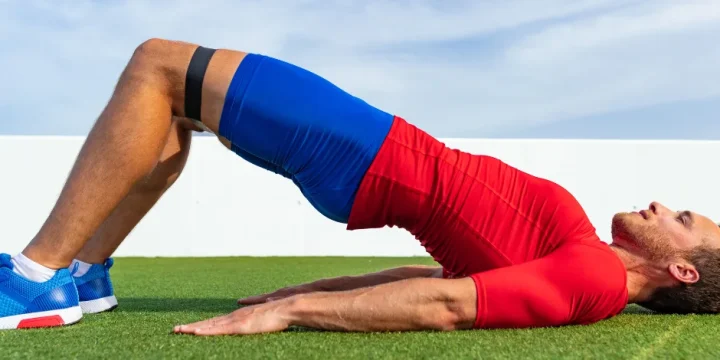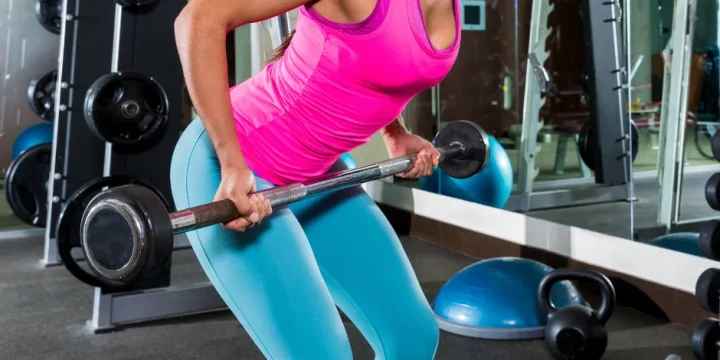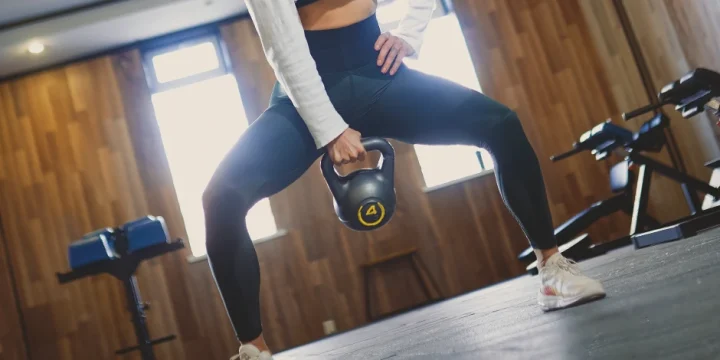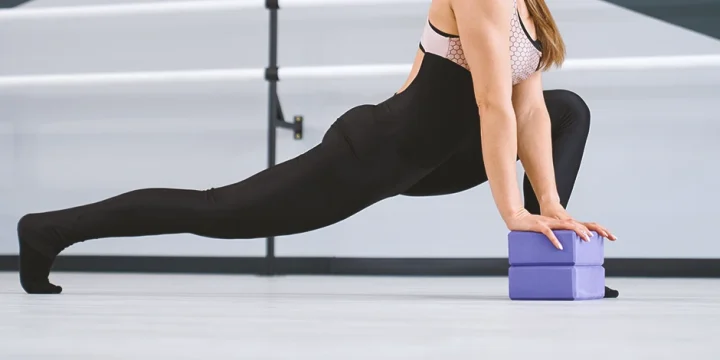The hack squat is a great exercise for building stronger and bigger leg muscles.
However, most gyms don't have the hack squat machine, or if a gym has it, the line to perform the exercise may be big, and some people prefer to do their workouts at home.
In that case, it's better to know and perform the hack squat alternatives that target the same muscle groups.
As a professional fitness coach, I will provide my expertise and findings on the best hack squat alternatives and how to program the exercises.
Quick Summary
- Some of the best hack squat machine alternatives include the traditional barbell squat, zercher squat, leg press machine, and front squat.
- The hack squat's position in the fitness routine is either as a secondary compound workout used to create most of the exercise stimulus or as the sole compound activity used to provide the exerciser with hypertrophy and strength conditioning.
- A study from ResearchGate found that the hack squat had the lowest stimulation of the erector spinae (the back muscle) and semitendinosus (the hamstring muscle) when various squat patterns were tested.
- To maintain the same muscle hypertrophy and workout stimulus without the downsides generally associated with the hack squat, you must substitute it with a similarly intensive and effective compound workout (or series of isolation exercises).
The Best Hack Squat Alternatives

Based on literally hundreds of my personalized workout programs, here are eight highly effective hack squat alternatives.
1. Leg Press
The quality home gym leg press machine is a machine-based lower-body complex exercise with a substantially reduced risk of injury compared to other free-weight leg workouts.
It is considered the hack squat's more quadriceps femoris muscles focused relative.
How to perform:
- Lie on the machine and place your legs on the platform.
- Your posture is similar to your back squat position.
- When you're ready, completely stretch your legs and release the safety latches.
- Begin by bending your knees till your thighs are roughly parallel.
- Push the platform from you to return to the starting position.
- Repeat for reps.
Related: Leg Press Foot Placement Positions
2. Front Squat
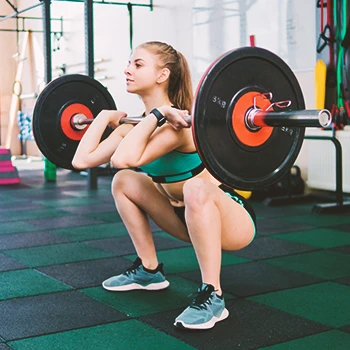
I recommend the front squat to both my beginner and intermediate clients. This exercise is distinguished by the placement of the barbell atop the exerciser's clavicles or chest shelf.
This results in significantly modified form mechanics that bring the exercise's muscular stimulation pattern nearer to that of a hack squat as opposed to a traditional bar squat.
How to perform:
- Set the bar to mid-shoulder height in the squat rack and bend your knees to get the hips beneath the bar. The bar will be located beneath your chin, towards your clavicle.
- Bring your thumbs to the exterior of your shoulders; this will be your grasp on the bar.
- Under the bar, pull the elbows out and forward.
- Straighten your legs and unrack the weight, then take a few steps back.
- Keep your core tight and your chest proud, with your elbows aligned with the shoulders.
- Maintain the bar over your midfoot and squat the hips until the thighs are parallel or lower.
- Drive explosively through the ground to get back to standing.
- Repeat for reps.
"Front squats boost the size of your wheels. Using progressive overload efficiently (increasing weight, repetitions, sets, etc.) will result in enormous muscle-building gains."
- Kate Neudecker, Sports Performance Nutritionist & Personal Trainer
Also Read: Kneeling Squat
3. Traditional Barbell Squat
The traditional squat, regarded as the king of lower body strength development exercises, is among the greatest available compound leg workouts, particularly as a substitute for the hack squat for athletic conditioning and bodybuilding.
How to perform:
- Take the bar off the rack, resting it on your back shoulder muscles.
- Take two large steps back and pose with both legs shoulder-width apart and your toes pointed slightly out.
- Maintain spinal alignment by gazing at a location on the floor approximately two meters ahead, then "sit" back and down as if aiming for a chair.
- Descend until the hip crease is slightly below your knee.
- Maintain your weight on the heels as you push back up.
- Repeat for reps.
4. Zercher Squat

The zercher squat is a considerably more advanced squat exercise that incorporates many form cues from the front squat.
It is more of a direct progression than an alternative to the hack squat, demanding extensive training expertise and high levels of physical strength across the entire body.
How to perform:
- Set up the bar in the squat rack at hip height, squat down, and position the bar in the crooks of the elbows.
- Stand up and clasp both hands together for further strength and stability if necessary.
- Squat down low with an erect body and knuckles toward the roof in a broader-than-typical squat position.
- Squat up and push through the ground, keeping your chest high.
- Reset and repeat, paying attention to maintaining a proper upright torso.
"The zercher squat can be employed as a hack squat alternative for those looking for a more intensive workout or one that eliminates a considerable amount of weight off the lower spinal column, lowering the risk of injury in that region."
- Daniel Dominik, Registered Physical Therapist
5. Safety Bar Squats
The safety bar squat employs a unique safety squat bar benefits that allows the lifter to focus on the same muscle areas as the hack squat.
The safety bar squat helps keep a more upright torso angle throughout the action.
With a more vertical body, your knees must go slightly forward to help keep you balanced, focusing on your quadriceps.
How to perform:
- Place the barbell at shoulder level on a rack.
- Place the barbell and foam on your back.
- Take hold of the handles and tuck the elbows into your sides.
- Stand and take a few steps backward to clear the hooks.
- Bend simultaneously at the knees and hips to lower yourself.
- After reaching a suitable depth, drive your legs into the ground to return to the starting position.
- Repeat for reps.
6. Barbell Hack Squat
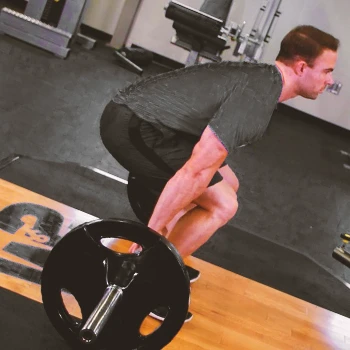
The barbell hack squat is considered substantially more challenging and advanced than the machine hack squat, which is why I don't recommend it for beginners.
This exercise is best saved for athletes or exercisers looking to take their fitness activities to the next level - in terms of intricacy, intensity, and rate of perceived effort.
You will impart weight to this action by holding a bar behind your feet.
With the barbell, you must bend your knees further to be balanced while remaining more erect. As a result, your quads work harder.
How to perform:
- Load a barbell as though you were about to do a deadlift.
- Place your foot in front of the bar.
- Bend your knees and hold the bar.
- Push the ground away to stand up.
- The barbell will slide down the back of your legs as you stand.
- Descend by simultaneously bending your knees and hips.
- Repeat for reps.
7. Belt Squat
The belt squat is a good replacement for the hack squat since you can precisely simulate the hack squat's erect torso and legs forward stance.
Many different versions of this squat may be performed, primarily depending on the equipment provided. You may use a squat machine (the most common form), a landmine connection, a good cable machine, or simply a pair of boxes and a dip belt.
"In the belt squat, the weight is fastened to a chain between the legs that are connected to a belt worn about your waist. As a result, this squat is an excellent leg day exercise for persons who have an upper-body injury or twitchy backs."
- Trevor Thieme, Certified Strength & Conditioning Specialist
How to perform:
- Wearing a dip belt, attach it to the squat machine with a carabiner (you may need to kneel for this).
- Place the feet in your desired posture without raising the plates.
- Place your hands gently on the railings and fully stand up.
- Remove the stopper to continue your descent undisturbed.
- Bend your knees while utilizing the handrails to stay balanced.
- When you've reached the proper depth, push the platform and stand up.
- Repeat for reps.
Related: Best Weighted Dip Belts
8. Bulgarian Split Squat
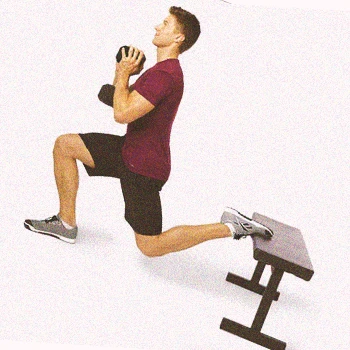
The Bulgarian split squat is a single-leg squat variation in which the rear leg is raised on a bench or a strong chair.
As a unilateral single-leg squat, the movement focuses on the quadriceps.
How to perform:
- Stand with the back against a bench that is around knee height. Take a large stride in front of the bench.
- Place one leg behind you on the bench.
- Inhale, face forward, and squat with stability until the rear leg's knee contacts the floor.
- While exhaling, reverse the motion and straighten your front leg again.
- Inhale at the apex and repeat for repetitions.
What Are Hack Squats?

Hack squats are a leg workout performed on a gym machine. The lifter stands in the lifting device with shoulder padding on and 'squats' a load up and down an inclined sled. It's a reverse leg press.
Advantages of Hack Squats
Hack squats are a good exercise that gives certain advantages.
These are a few benefits of doing hack squats:
- Lifting to failure is permitted because it is machine-based and not likely to cause harm.
- Because it is a mechanical movement, little to no technique is required.
- Lifters suffering from back pain may benefit from a lack of trunk involvement.
Even with these advantages, there are superior alternative squat patterns.
This is supported by studies as well. A study from ResearchGate found that the hack squat had the lowest stimulation of the erector spinae (the back muscle) and semitendinosus (the hamstring muscle) when various squat patterns were tested [1].
As a result, their overall efficacy is reduced, and they may be damaging for individuals with knee issues.
This is significant because lower hamstring engagement is necessary for knee stability [2].
The outcomes of this study support prior findings that trunk engagement in the back barbell squat was greater than in the hack squat with the same relative weights [3].
If you've had knee problems in the past, I'd recommend staying away from hack squats, especially heavy ones.
Machines do not develop athleticism or movement efficiency; therefore, hack squats will not assist you much if you want to be more athletic [4].
Also Read: Reverse Hack Squat How-to Guide
What Makes the Best Hack Squat Alternative

We've given you the greatest hack squat alternatives and how they mirror the various advantages of hack squats.
When we look at the key advantages of the hack squat, we see that there are two features that a good hack squat alternative must have:
- Excellent quadriceps activation: As mentioned previously, one of the most important aspects of the hack squat is its capacity to engage the quadriceps. The hack squat is an excellent quad development exercise since it works the whole lower body. As a result, one thing to consider while looking for a hack squat replacement is the quadriceps' function in the exercise. Being involved isn't enough; you need an activity where the quads are the primary mover.
- Easy on the back: If you've ever experienced an achy back from squats, you know how uncomfortable it is. Back squatting may be an unpleasant experience if you have a painful back, irrespective of how it got that way. The hack squat firmly supports the back throughout the exercise. This makes it a fantastic alternative for anyone who wishes to put extra strain on their lower body while also being mindful of their back. As a result, our alternatives should be less taxing on the lower back.
Who Should Look for a Hack Squat Alternative?

People with a back or knee injury should look for a hack squat alternative. Also, if your gym doesn't have a hack squat machine or if you want more stabilizer muscle activation, you should look for a hack squat alternative.
Hack squats can exacerbate back pain due to spinal loading, even on a machine. A belt squat machine is a better option for those with back problems, as it reduces spinal strain.
Hack squats can also be tough on the knees. Alternatives like belt squats, leg presses, or goblet squats are gentler and equally effective. Before trying new exercises, especially if you have injuries, consult a physical therapist to understand your range of motion and safe workout options.
If your gym doesn’t have a hack squat machine, or if you're seeking more challenging workouts, consider free-weight exercises like barbell lunges, Bulgarian split squats, or front squats. These not only offer new challenges but also engage more stabilizer muscles, providing a more comprehensive workout.
Ultimately, the best hack squat alternative depends on your needs and preferences. Experiment with different exercises to find the best fit for your workout routine.
Related: 7 Squat Variations That Will Skyrocket Your Leg Gains
How to Program Hack Squat Alternatives
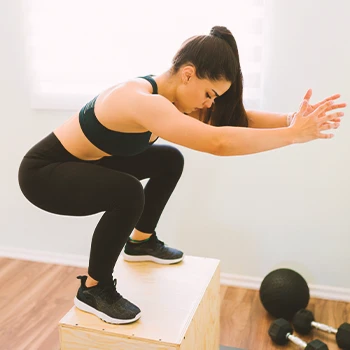
Most hack squat alternatives can be programmed in the same way as a regular hack squat can.
Three sets of 12 repetitions at a rate of perceived exertion (RPE) of roughly seven would be a typical example of hypertrophy development. For hypertrophy, a rest period of 60 to 90 seconds is recommended [5].
Alternatives to the hack squat, such as the goblet squat, may need more repetitions each session. Hack squat machines can support a significant amount of weight.
The weights accessible at your training facility and what you can grasp in front of you restrict goblet squats.
A crush grip goblet squat option might be programmed as 3 sets of 15 repetitions at 7 to 8 RPE with 60-second intervals of rest between sets.
You can utilize greater weights using a hack squat substitution, such as the belt squat. Belt squats are an excellent alternative to hack squats, particularly if strength is your aim.
A belt squat for conditioning might be programmed as 4 sets of 6 repetitions at 8 to 9 RPE with a 3 to 5 minutes rest interval between sets.
Related posts:
Enhancing Balance and Stability: The Neuromuscular Advantages of Unilateral Leg Training
When it comes to building leg strength and size, traditional bilateral exercises like the hack squat are often the go-to.
However, I've helped many clients by adding unilateral exercises to their program. These work one leg at a time and offer unique neuromuscular benefits that can significantly enhance your training regimen.
Here's why incorporating unilateral leg exercises is essential for a well-rounded leg workout.
1. Improved Muscle Balance and Symmetry
Unilateral exercises such as single-leg squats or lunges address imbalances between the legs. Most individuals have one dominant leg, and bilateral exercises can often exacerbate this imbalance.
Training one leg at a time ensures that both legs do equal work, promoting symmetrical muscle development and reducing the risk of injury.
2. Enhanced Proprioception and Stability
Unilateral training improves proprioception — your body's ability to sense its position in space. This enhanced body awareness leads to better balance and stability, both critical for athletic performance and daily activities.
Exercises like the Bulgarian split squat or single-leg deadlifts require significant stabilization, engaging not just the primary leg muscles but also the smaller stabilizing muscles around the ankles, knees, and hips.
3. Increased Core Engagement
Performing exercises on one leg dramatically increases the demand on your core muscles to maintain balance and posture.
This inadvertent engagement of the core provides a secondary benefit of strengthening the abdominal and lower back muscles, contributing to overall core stability and strength.
4. Functional Movement and Athletic Performance
Unilateral exercises mimic real-world movements and athletic activities more closely than bilateral exercises. Most sports and daily activities involve single-leg movements.
By training unilaterally, you're not only building strength but also improving your functional movement patterns, which can enhance athletic performance and reduce the risk of sports-related injuries.
5. Accessibility and Versatility
Unilateral exercises often require minimal equipment and can be performed anywhere, making them highly accessible. Whether it's lunges, step-ups, or single-leg squats, these exercises can be easily modified to suit your fitness level and available equipment, making them a versatile addition to your workout routine.
FAQs
Which Muscles Do Hack Squats Work?
The muscles worked by the hack squat are the hamstrings, calves, glutes, and quads.
What Is the Same as a Hack Squat?
The front squat is the same as a hack squat. The front squat is a wonderful lower-body workout and an ideal substitute for the hack squat.
What Is a Good Morning Alternative To Reverse Hack Squats?
The good morning alternative to reverse hack squats is the single-leg squat, lunge, single-leg deadlift, Bulgarian split squat, and reverse lunge.
Supplementing Your "Hack Squat Alternatives" Exercises
A fantastic hack squat substitute involves a similar motion pattern or engages identical muscle groups, particularly the quadriceps, and glutes.
When performed with intent, any of the exercises outlined in this article may be incorporated alongside the hack squat in your training regimen.
Be sure to eat healthily, get enough rest, and replenish your energy levels using these best post-workout supplements.
Upon testing, the supplements helped reduce muscle soreness and boosted the recovery process, helping us overcome muscle fatigue and be ready for our next workout session.
References:
- https://www.researchgate.net/publication/337400852_
- https://pubmed.ncbi.nlm.nih.gov/30421166/
- https://pubmed.ncbi.nlm.nih.gov/28704312/
- https://www.researchgate.net/publication/322901416_
- https://pubmed.ncbi.nlm.nih.gov/19691365/
About The Author
You May Also Like
